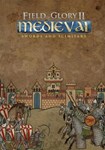DLC Field of Glory II: Medieval - Swords and Scimitars
Positive responses: 0
Negative responses: 0
Sold: 0
Refunds: 0
Seller: vokrugmira
information about the seller and its items
Loyalty discount! If the total amount of your purchases from the seller more than:
| $50 | the discount is | 2% |
| $100 | the discount is | 3% |
$4.96
💥Instant 24/7 product delivery immediately after purchase!💥 The product is delivered automatically even if we are offline.
❗️Please pay attention to the product specifications before purchasing❗️
🌟 (DLC) Field of Glory II: Medieval - Swords and Scimitars 🌟 This product is an addition to the game. To activate it, you need to have the main game.
Specifications:
Type: Activation Key
Activation region: Russia and the CIS
Client for the game: Steam
Localization: Completely in English
Platform: PC
Year: 2021
---------
Description:
The Byzantine Empire of the early 11th century was in a strong position - they pushed their border eastward from the fragmented Muslim emirates and completely destroyed the Bulgars in the Balkans. Everything changed in 1071, when they suffered a catastrophic defeat from the Seljuk Turks at the Battle of Manzikert. These nomadic conquerors had recently converted to Islam and quickly established a sultanate ruling from Afghanistan to Palestine. Following Manzikert, they took away almost all of Anatolia from the Byzantines. When the Byzantine emperor Alexios Komnenos tried his best to stop the Seljuk advance, he turned to the West for mercenaries. This request was seized upon by Pope Urban II, who may have seen in it an opportunity to achieve his own goals. At the Council of Clermont in 1095, he called for a crusade to save the Eastern churches and reclaim the Holy Land from the Muslims. The timing was good, as the powerful Seljuk empire began to disintegrate, the Sultanate of Rum in Anatolia (modern Asian Turkey) separated from the Great Seljuk Empire in 1077, and the local Syrian Athabegs in practice turned out to be semi-independent and disunited. The First Crusade eventually captured Jerusalem in 1099 and established a number of crusader states in Palestine and Syria. Thus, they caused fierce hostility between Muslims, Western Christians and the Byzantines, which led to two centuries of conflict. The first was followed by several major crusades, as the Crusader states fought for their existence against a number of revived Islamic states: the Fatimids, Zangids, Ayyubids and, finally, the Mamluks, who in 1291 destroyed the last Crusader stronghold in Acre. Meanwhile, further east, a much greater threat to Islamic civilization has arisen. The rapidly expanding Mongols destroyed the Khorezm shahdom by 1231, the Christian kingdom of Georgia fell in 1239, and the Seljuks were defeated and forced to become vassals in 1243. By 1258, the assassins of Alamut and the ruins of the once great Abbasid caliphate had also been conquered. Only the Mamluks of Egypt were able to finally put an end to the Mongol offensive with their victory at Ain Jalut in 1260. In the Balkans, the Byzantine Empire remained strong until 1204, when Constantinople fell during the Fourth Crusade. After that, most of the old empire was taken over by the Western Crusaders and the Venetians, who ran the whole nefarious enterprise. The Byzantines held out in four fragments: the Trebizond and Nicene Empires and the despots of Rhodes and Epirus. In the end, the Nicene Empire regained Constantinople in 1261, but the power of the Byzantines was forever broken, and now they were only a secondary state. Key Features: 20 more nations and factions spanning Southeastern Europe and the Middle East from 1040 to 1270 AD. These include Arabs (Syria/Iraq), Armenians (Cilicians), Bulgarians, Byzantines (the main empire, as well as Nikaya, Epiros and Trebizond), Crusaders, Cypriots (Kingdom of Lusignan), Daylami, Fatimid Egyptians, Georgians, Ghaznavids, Ghurids, Indians (Rajput, other Hindus, Muslims), Khorezmians, Latin states in Greece, Mamluk Egyptians, Mongols (Ilkhanids), Pechenegs, Seljuk Turks, Serbs and Syrian states. Each of them has its own historically accurate banner. Another 35 units (11 brand new, 24 new in the Middle Ages), allowing you to accurately represent the troops of all new factions
No feedback yet










